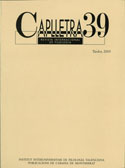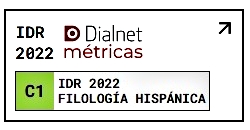Entre la dixi i la definitud: els verbs de moviment resultatiu en català
DOI:
https://doi.org/10.7203/caplletra.39.4852Paraules clau:
semasiology, verb «venir», medieval catalan language Resum
Resum
This article intends to present a brief study on the semasiologic extension of the Catalan verb «venir» —«to come»— in the old and mediaeval language, in contrast to the verb «anar» —to go. It is maintained here that the verb to come in the old language had a more extense meaning than in the current language, fundamentally in relation to the contexts of movement towards a place not occupied by any of the interlocutors of the speech. To elaborate this analysis we start from a corpus of thirty-five texts, which includes four centuries, from the first-known texts written in Catalan (at the end of the twelfth century, beginning of the eleventh century) to the sixteenth century.
 Descàrregues
Descàrregues
Descàrregues
Publicades
Com citar
-
Resum653
-
PDF332
Número
Secció
Llicència
L’autor o autora que adrece un treball a la redacció de Caplletra perquè siga publicat ha de ser la persona titular legítima dels drets d'explotació. La legitimació per a la publicació del treball ha d’incloure també les imatges, les taules, els gràfics i altres materials que puguen complementar el text, amb independència de si n'és l'autor o autora.
Copyright. Quan publica el treball en la revista, l'autor o autora cedeix a Caplletra. Revista Internacional de Filologia els drets d'explotació (reproducció, distribució i comunicació pública), tant per a l'edició impresa en paper com per a la versió electrònica, que serà accessible mitjançant la xarxa Internet.
Tots els treballs publicats en Caplletra es troben sota una llicència Creative Commons del tipus Reconeixement-NoComercial-SenseObraDerivada 4.0.
RESPONSABILITAT
Caplletra. Revista Internacional de Filologia no s'identifica necessàriament amb els punts de vista mantinguts en els treballs que publica.
Caplletra. Revista Internacional de Filologia declina tota responsabilitat derivada de qualsevol vulneració eventual dels drets de propietat intel·lectual que poguera ser duta a terme pels autors o autores.






